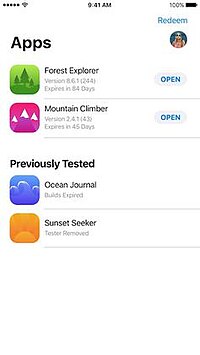TestFlight
 TestFlight app running on an iPhone | |
| Original author(s) | Benjamin Satterfield Trystan Kosmynka |
|---|---|
| Developer(s) | Apple Inc. |
| Stable release | 3.0.1
/ January 25, 2021[1] |
| Operating system | iOS tvOS iPadOS macOS |
| Type | Application testing service |
| License | Freeware |
| Website | developer |
TestFlight is an online service for over-the-air installation and testing of mobile applications, currently owned by Apple Inc and only offered to developers within the iOS Developer Program.[2][3][4] Developers sign up with the service to distribute applications to internal or external beta testers, who can subsequently send feedback about the application to developers.[5][6][7] The TestFlight SDK additionally allows developers to receive remote logs, crash reports and tester feedback.[8]
TestFlight initially supported testing of Android and iOS applications, but since March 2014, Apple has retracted support for Android.[9][10] As of 2015, applications must be published for TestFlight using Xcode, and testers must be invited using iTunes Connect.[5] After invitation, up to 25 internal testers (with up to 10 devices each) and 10,000[11] external beta testers can download and test the application build. Up to 100 apps can be tested at a time, internally or externally.[5] Testers may be grouped and separate builds created for each group.[5] The TestFlight application for iOS notifies testers when new builds are available, features to focus on, and enables sending of feedback.[5]
History[]
TestFlight was founded by and on December 23, 2010, and was designed as a single platform to test mobile applications on Android and iOS devices.[12] It was acquired by Burstly in March 2012, and thereby gained the resources necessary to launch TestFlight Live.[12]
In 2011, Burstly raised $7.3 million from Upfront Ventures, Rincon Venture Partners, Softbank Capital and others.[10] Apple Inc. acquired Burstly in February 2014, and terminated support for Android as of March 2014.[9][10] Apple also shut down FlightPath (a mobile analytics solution and a replacement to TestFlight Live) and SkyRocket (a mobile application monetization platform) the same month.[10][13]
References[]
- ^ "TestFlight". App Store. Retrieved May 7, 2021.
- ^ Developing Enterprise iOS Applications: iPhone and iPad Apps for Companies, O'Reilly Media, Inc., December 12, 2011
- ^ Yeung, Ken (February 21, 2014). "Apple confirms that it has acquired TestFlight creator Burstly". The Next Web.
- ^ TestFlight has moved, Apple Computer
- ^ a b c d e TestFlight Beta Testing, Apple Computer
- ^ Architecting Mobile Solutions for the Enterprise, O'Reilly Media, Inc., May 14, 2012
- ^ Swift Development with Cocoa: Developing for the Mac and IOS App Stores, O'Reilly Media, Inc., December 10, 2014
- ^ Game Development for iOS with Unity3D, CRC Press, July 26, 2012
- ^ a b Garun, Natt (January 26, 2015). "Apple to close the old standalone TestFlight beta testing service next month". The Next Web.
- ^ a b c d Perez, Sarah; Lawler, Ryan; Etherington, Darrell (February 21, 2014). "TestFlight Owner Burstly Acquired By Apple". TechCrunch. AOL.
- ^ Miller, Chance (July 31, 2017). "Apple expands TestFlight tester limit to 10,000 users". 9to5Mac. Retrieved September 15, 2017.
- ^ a b Constine, Josh (March 5, 2012). "Why Did TestFlight Sell To Burstly? "We Couldn't Change The App Ecosystem Alone"". TechCrunch. AOL.
- ^ Lunden, Ingrid (March 13, 2014). "After Apple Acquisition, Burstly's SkyRocket Users Get 90-Day Notice". TechCrunch. AOL.
See also[]
- iOS
- Apple Inc. services
- IOS software
- Apple Inc. acquisitions
